Views



Editor:
Justo Castaño, Spain
Email: justo@uco.es
Co-Editor: Martin Reincke, Germany
Email: ese.president@ese-hormones.org
Editorial Board: Adrian Clark, UK
Olaf Dekkers, The Netherlands
Karim Meeran, UK
Stavroula Paschou, Greece
Marija Pfeifer, Slovenia
Robert Semple, UK
Walter Vena, Italy
Victoria Withy, ESE Office
Maria Chiara Zatelli, Italy

Managing Editor: Caroline Brewser
Design: Qube Design Associates
Website: www.ese-hormones.org
©2022 European Society of Endocrinology
Cover Image: ©iStock.com/luigi giordano
The views expressed by the contributors are not necessarily those of ESE. This document is available on the ESE website, www.ese-hormones.org
The addresses used to mail this issue of Endocrine Views were supplied by the members of ESE and are stored in Bioscientifica’s database for future use.
If you do not wish to receive further mailings, please advise info@euroendo.org
ESE thanks the following for their support.
Premium Corporate Members: Ipsen, Novo Nordisk, Pfizer, Recordati Rare Diseases, Takeda Corporate Members: Abiogen, Alexion Pharma GmbH, Amryt Pharmaceuticals, HRA Pharma, Kyowa Kirin International Supporters: Crinetics Pharmaceuticals, Soleno Therapeutics
is always a period
find all the
need
Endocrine nurses are an essential part of any clinical endocrine team. In this issue, we interview Sherwin Criseno, ESE Nurse Committee Chair, who tells us about the plans that are in hand to increase ESE’s support for nurses even further (page 7). On page 13, Andrew Dwyer reflects on how the evolution of endocrine nursing societies has parallelled the development of modern medicine. Two patients’ perspectives further remind us of the importance of our nurse colleagues, on page 16.
Excitingly, the recipient of the inaugural European Endocrine Nurse Award has recently been announced. We congratulate Cecilia Follin, who will deliver her award lecture at ECE 2023 in Istanbul, Turkey on 13−16 May. Remember to submit your own work to the Congress by the abstract deadline of 23 January 2023, and register before the early bird deadline of 18 April.
Change is also happening at European Journal of Endocrinology, which is moving to a new publishing house from January 2023. You can read about the developments, including the journal’s new look, on page 6.
As an Editorial Board, we decided to shine a light on updates from the world of adrenal and cardiovascular endocrinology in this issue. The diversity of news and information available in that field has led to a multitude of opinions and features. On pages 8 and 9, colleagues look at the latest findings from a range of approaches to combatting cardiovascular disease. Then, on pages 10−12, we look at important progress in the development of management options for a variety of adrenal disorders.
Finally, I draw your attention to ESE’s ongoing drive to promote diversity, equality and inclusivity within the Society. On page 5, our President, Martin Reincke, examines progress in this area, on this occasion particularly looking at gender equality.
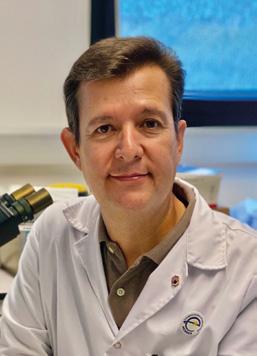



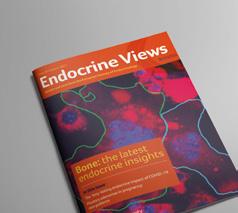

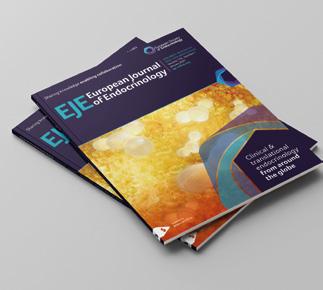



The 9th Meeting of the ESE Young Endocrinologists and Scientists (EYES) was the first EYES Meeting to take place in person since 2019, because of the pandemic. It was held in Zagreb, Croatia, on 2−4 September and attracted over 150 participants from 22 countries.

Congratulations are due to James Wilmouth Jr (France) and Alessandro Prete (UK), recipients of the awards for the two best abstracts. They received free registration for ECE 2023 in Istanbul, Turkey, and for the Croatian Society for Endocrinology and Diabetology’s 2023 Annual Meeting respectively, where they will give presentations on their work.
The ESE Summer School took place for the first time since 2019 on 17−20 July in Innsbruck, Austria. Delegates enjoyed brilliant, interactive talks covering the ESE Focus Areas, from clinical and basic research perspectives. During the group work breakout sessions, attendees discussed topics face-toface with international experts.
The ESE Young Endocrinologists and Scientists (EYES) Committee organised several recreational
and sporting activities, including swimming in the Lanser See, football, table tennis and karaoke, which allowed participants to enjoy themselves while networking.
Thanks are due to Chairs Josef Köhrle and Martin Fassnacht.
ESE Summer School 2023 will take place on 18–21 June 2023 in Innsbruck. Details will follow shortly.
I hope everyone had a great summer!
In the ESE Office, we are busy planning for 2023. In particular, we are working hard on the upcoming 25th European Congress of Endocrinology in Istanbul, Turkey, which will take place on 13−16 May 2023. Make sure you mark the important abstract deadline on 23 January 2023 and early bird registration deadline on 18 April 2023 in your diaries. A large number of grants will be available to help you attend.
We look forward to welcoming you to this, our second face-toface Congress in 4 years, as well as to building on the success of the wonderful ECE 2022 in Milan, Italy. We thank the Society of
Endocrinology and Metabolism of Turkey for their support and collaboration as we prepare for ECE 2023. I know it will be another truly inspiring gathering, and also great fun!
This issue of Endocrine Views illustrates a clear trend towards returning to face-to-face meetings, with the reports above from Zagreb, Croatia, where the ESE Young Endocrinologists and Scientists met for EYES 2023, and Innsbruck, Austria, which hosted the ESE Summer School. We have also just hosted the first face-to-face Postgraduate Training Course in Clinical Endocrinology, Diabetes and Metabolism in 3 years, in Tbilisi, Georgia – a meeting which was held in a hybrid format for the first

time. It feels that, to a large extent, ‘normality’ has returned: long may it continue.
As you receive your membership renewal notification, make sure to look at page 3 for the incredible range of benefits that are available to members. Our aim is to provide a great value package which is relevant right across our broad membership base. We are working to make these benefits as accessible and easy to identify as possible, for you personally, through improved marketing efforts. We look forward to welcoming you as a member in 2023, and to you remaining part of our community – Because Hormones Matter!
As always, please get in touch if you have any feedback.
Helen Gregson Chief Executive Officer, ESE helen.gregson@ese-hormones.org
Your President, Martin Reincke, emphasises the enduring benefits of being a member of the ESE community, and his enthusiasm to ensure that the Society is a model of equality, diversity and inclusivity.

As we approach the moment where you consider your renewal for 2023, I would like to start with a word on membership. Thank you for being a member of ESE this year; we hope you have found it to be valuable and fulfilling. Our aim is to ensure that each member of ESE feels a part of our community, and that what we offer is valuable to your career.
We are proud to provide an extensive range of benefits, including reduced fees to ECE and to all our educational events, as well as numerous grants, so that these events are as accessible as possible. Our ESE On Demand platform provides a valuable selection of content across all of the ESE Focus Areas. If you register for an event as an ESE member, you will receive access to its content – enabling you to catch up at a time which is convenient for you.
We also aim to keep our community up to date with developments in the field, with emails straight to your inbox, benefiting you on a daily basis. And, to support your scientific knowledge, you will receive complimentary access to our worldleading journal, European Journal of Endocrinology.
This is all in addition to being part of our wonderful community, which I am so proud to lead – and it is yours from only €10 per year!
One important update for you: after many years of working with Bioscientifica as our publisher, we have decided to move European Journal of Endocrinology to Oxford University Press from 1 January 2023. On behalf of ESE, I thank Bioscientifica for their invaluable work on the development of our journal to become one of the

We congratulate Cecilia Follin, inaugural winner of the European Endocrine Nurse Award.
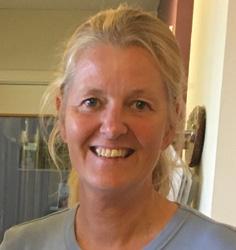
Cecilia is an Associate Professor in Endocrinology and Senior Lecturer in Nursing at the Institution of Healthcare Science, Lund University, Sweden. Her areas of interest include late complications of childhood cancer and pituitary disorders.
She is an initiator and former Chair of the Nordic Network of Endocrine Nurses and a founding member of the ESE Nurse Committee.
You will be able to see her lecture at ECE 2023 in Istanbul, Turkey.
leading endocrinology journals in the world!
My other focus as I write to you is on one of the great priorities of my presidency – to ensure diversity within ESE. We now have a clear statement on equality, diversity and inclusion (www.ese-hormones.org/ equality-diversity-inclusion). The four areas we are working on are gender, age, country size and geographical location. For the purposes of this article, I would like to comment on the issue of gender.
I was delighted to attend the successful launch of the European Women in Endocrinology initiative at ECE 2022, which aims to help promote and facilitate the professional development and advancement of women in the wider field of endocrinology. This group now has a dedicated page on the ESE website (www.ese-hormones. org/euwin), and is working on a set of important activities.
We have some interesting statistics on gender – and we are doing better in some areas than others!
Some 47% of ESE members are female. There is growing representation of women across ESE Committees and Boards, and a commitment to increasing this through various governance policies. These policies include all Committee nominations now being reviewed by the Nominations Committee for gender diversity, as well as age, career stage, and country location and size.
On the other hand, we do need to improve representation among our Committee positions, which
currently stand at 35% female and 65% male (as at June 2022). There is also work to do around our Awards, with more awards historically being presented to men than to women (75% male/25% female since 2011) − but more grants (of all types, for everything from research to travel) being given to women than men!
These data demonstrate that we face a challenge in this area, but we are taking the right steps towards addressing matters where there are still issues. In my remaining months as your President, I keenly anticipate working on this, as well as on many other areas.
Finally, please make a note of the dates of the 25th European Congress of Endocrinology in Istanbul, Turkey: 13−16 May 2023 (further information on page 3).
I look forward to welcoming you back as members for 2023.
Martin Reincke ESE President @EsePresidentFrom January 2023, publication of ESE’s leading journal, European Journal of Endocrinology (EJE), will move to longestablished academic publisher Oxford University Press (OUP). This is an exciting move for the journal, while ESE members will still benefit from preferential arrangements. The journal will have a new cover design (see below), and a new website.

OUP currently produces over 500 academic journals, two-thirds of which are published in collaboration with learned societies and other international organisations. OUP will work with ESE to continue to stimulate the growth in EJE’s Impact Factor. They will support the journal’s ongoing development in the rapidly changing publishing environment, including the drive toward open access.
You will still be able to read the latest research free of charge through the members’ area of the website, and benefit from reduced rates on print subscriptions. ESE members will also benefit from a new 50% discount on APC (article processing charge) fees and a new simplified structure for page and colour charges from January 2023.
‘EJE continues to be a top choice for authors, with its increasing Impact Factor and citations. This, coupled with OUP’s wide reach and relationships with institutions across the globe, will increase its visibility and growth even further.’
Wiebke Arlt, Editor-in-Chief, EJE
ESE recently reviewed the uptake by members of various benefits. We discovered that only a very small number of you have used the free online access to the UK Society for Endocrinology’s Journal of Endocrinology, Journal of Molecular Endocrinology and Endocrine-Related Cancer that has been available via the ESE member log-in, or the reduced price print subscription.
To make best use of ESE funds, our reduced price arrangements for access to these journals will therefore cease from 1 January 2023.
As ESE members, you will continue to benefit from free online access to articles in European Journal of Endocrinology and reduced rate print subscriptions, plus preferential publication charges (see above).
You will still receive a 40% discount on publishing charges for the open access journal Endocrine Connections.
ESE members, plus ECE and EYES Meeting delegates, will also continue to enjoy a 25% discount on APC (article processing charge) fees for the online, open access publication Endocrine, Diabetes & Metabolism Case Reports.
‘ESE is grateful for the professional publishing support received from Bioscientifica in the last two decades. We continue to develop and advance and are excited to bring our flagship journal together with OUP to take it to the next stage of its journey.’
Martin Reincke, ESE President‘OUP is delighted to be working collaboratively with ESE and looks forward to the future strategic development and growth of EJE.’
Deborah Dixon, Publishing Director, OUP


We congratulate Justo Castaño, Editor of Endocrine Views, on his recent appointment as Editor-inChief of Endocrine Oncology, an official journal of the Society for Endocrinology. This open access, peer-reviewed journal publishes basic, translational and clinical research and reviews on topics related to the relationship between hormones and cancer. Find out more at https://eo.bioscientifica.com.
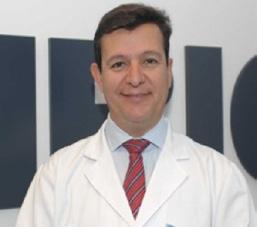

Sherwin Criseno is a Consultant Nurse in Endocrinology at University Hospitals Birmingham NHS Foundation Trust, UK, and Chair of the ESE Nurse Committee. We take this opportunity to talk to him about his passion for endocrine nursing, and the support ESE provides for nurses through a range of initiatives.
What led you to become an endocrine nurse?
I wasn’t planning to specialise in endocrinology, and I always say that it happened through divine intervention. In 2009, I was asked to look at developing the nurse-led service (particularly introducing nurse-led clinics) in a tertiary endocrine centre. After 6 months of working in endocrinology, I found myself immersed in this challenging but rewarding area of clinical practice.
What are your top tips for someone choosing to work in endocrine nursing?
The world of endocrinology could potentially be quite overwhelming. You need to take time to understand the multiple, complex disease entities within the specialty. Do not give up. Take each day as a learning opportunity that will eventually culminate in greater understanding of the different aspects of endocrinology. Opportunities for personal and professional development are always available.
ESE provides a network of support, a platform for training and development, opportunities for involvement in research and the chance to meet like-minded professionals in a very friendly and welcoming environment. Through ESE, nurses have the chance to get involved in activities and raise the profile of their role in endocrinology, not just locally but also internationally.
As a member, you could enjoy attending or presenting your work during the extensive nurse programme at ECE, and receive a travel grant to help you get there. You would have the chance to join an ESE Committee or Guideline Working Group, to have a role in shaping the future of our field and of endocrine nursing. You might participate in online training courses specifically targeted at endocrine nurses. You could also be recognised for your contribution to endocrinology, with the new European Endocrine Nurse Award!
There should be an internationally agreed standard in terms of the acceptable minimum number of endocrine nurses that each endocrine service MUST have. However, due to the inherent differences in legal and professional frameworks that govern nursing practice in each European country, this is an issue that would have to be addressed at the level of the European Commission. Hopefully this will be possible in the future.
ESE’s formalisation of the Nurses’ Working Group into the ESE Nurse Committee in 2019 gave appropriate recognition of the crucial role of endocrine nurses in the endocrine service. This was supported by establishment of the first international award for endocrine nurses, the European Endocrine Nurse Award, which recognises excellence in nursing practice, research, leadership, training and patient engagement, and raises the profile of our work. I congratulate Cecilia Follin (Sweden), the first recipient, who will receive her award and give a lecture at ECE 2023 in Istanbul.
What new ESE initiatives support endocrine nursing? There are several exciting developments.
We are working on a proposal for a European Endocrine Nurse Exchange Programme which will potentially launch in 2023. It would aim to provide learning and networking opportunities for endocrine nurses in European countries where endocrine nursing practice is not yet well-developed, so that they can learn from nurses practising at an advanced level elsewhere.
The ESE Nurse Committee is reviewing the current training provision and opportunities
for endocrine nurses across Europe, with a view to providing an educational framework that outlines the required training programme essential for endocrine nurses.
We are also working closely with the UK Society for Endocrinology Nurse Committee to translate the Competency Framework for Adult Endocrine Nursing into more languages, so that nurses have a clear framework for their ongoing professional development. It is already available in French, German, Polish and Spanish, with work underway to provide Chinese, Dutch, Italian and Russian versions.
Working with patients and their families is the most rewarding part of the job. Enabling and empowering patients to effectively self-manage their long term conditions provides the ultimate testament to the value of the role of endocrine nurses.

It may seem ‘sad’, but the tranquillity of being away from the hectic clinical environment gives me an opportunity to focus on developing patient management pathways and training programmes for patients and families, as well as nurses. However, my extremely energetic and impatient 18-month-old beagle only allows me a maximum of 4 hours of my day off to spend on work. The rest of my time must be solely dedicated to him and my partner!
The ESE Nurse Committee is keen to reach out to all endocrine nurses across Europe. We want to hear from you and know about your work and your group.
As part of our ongoing commitment to support endocrine nurses in Europe, we would like to join your next regional or annual meeting. Please let us know when your next nurse event will be by emailing info@euro-endo.org.

Cardiovascular disease takes many forms, and is associated with a wide range of risk factors, ranging from lifestyle factors such as diet and exercise, to co-morbidities including diabetes and hypertension. It is perhaps unsurprising, therefore, that a diverse range of therapeutic approaches is proving useful in improving cardiovascular health. We have invited experts to consider some of the latest developments in this field.
Who would have thought that a novel drug generated to tackle obesity would ever give similar results in terms of body weight reduction to those obtained by bariatric surgery? Yet, reports on the first trial of tirzepatide in patients who are overweight or have obesity show that we have taken a revolutionary step forward in the field of obesity treatment.
Tirzepatide is a dual glucose-dependent insulinotrophic polypeptide (GIP) and glucagon-like peptide-1 (GLP-1) receptor agonist. More than the predictable simultaneous improvement in all the other cardiometabolic parameters, what is really astonishing are the data related to the percentage body weight loss: 62.9% and 39.7% of patients treated with tirzepatide (15mg) were able to lose more than 20% and 25% of their initial body weight respectively, compared with 1.3% and 0.3% seen in patients receiving placebo.1
These results demand a fundamental repositioning of the guidelines and the rules for anti-obesity drug approval. We should ask whether a placebocorrected weight loss of at least 5% of baseline weight after 12 months of treatment is, in itself, sufficient as a valid primary efficacy criterion before approval of an anti-obesity drug (as requested by the European Medicines Agency). Given that bariatric surgery is currently regularly reimbursed, maybe we should be thinking about anti-obesity drug reimbursement?
Despite these spectacular findings, some questions remain. What is the role of GIP activation in association with the well-known effect of GLP-1? What is the effect of this body weight loss in preventing major adverse cardiovascular events? New scheduled trials should provide the answers, and may pave the way to drug reimbursement.
In addition, we must ask whether such a drug could be routinely used if bariatric surgery is followed by a disappointing body weight regain? Will this class of drugs also be able to combat other diseases associated with obesity, such as polycystic ovary syndrome? Or in the management of often dramatic weight gain after hypothalamic surgery?
At this stage of drug development, such questions are the norm. In any case, now more than ever before, we are in a position to tackle obesity and its worldwide expansion more efficiently.
Identifying the best dietary strategy to prevent the recurrence of atherosclerotic cardiovascular disease events has been an active field of research in recent decades.
Diet is one of the key factors influencing the development of atherosclerosis, which, in turn, is the main factor underlying the development of cardiovascular disease. The first widespread public health strategies to improve diet from a cardiovascular perspective were set out by the American Heart Association in the form of the Adult Treatment Panel and National Cholesterol Education Program, published in the early 2000s. At that time, in the light of existing evidence, preference was given to reducing total fat, and a low-fat diet (15−30% of calories as fat) was recommended.
These documents were active for years, until evidence developed suggesting that the type of dietary fat may be important in influencing the occurrence of cardiovascular disease. Thus, the recommended fat restriction applied mainly to saturated and trans fats, and total fat was not established as an important determinant of atherosclerosis in recent guidelines from scientific bodies.
Data on primary prevention suggested that the Mediterranean diet may be protective in those at cardiovascular risk compared with a control diet. However, there was no evidence that, in secondary prevention, the Mediterranean diet could benefit people with cardiovascular disease when compared with a cardiovascular-healthy low-fat diet. In the Cordioprev study, 1002 patients with established cardiovascular disease were randomised to either a low-fat diet or a Mediterranean diet rich in virgin olive oil for 7 years. The primary endpoint comprised major cardiovascular events (myocardial infarction, revascularisation, peripheral artery disease, stroke or cardiovascular death).
The study found that the Mediterranean diet performed better than the low-fat diet, with a relative risk reduction ranging from 25% to 30% in the different statistical models tested. This risk reduction was more evident in men (around 35%). Importantly, the observed relapse rates (17% for the Mediterranean diet and 22% for the low-fat diet) were lower than expected from similar studies (30−35%), suggesting that both diets were indeed effective in preventing cardiovascular disease events, although the Mediterranean diet performed better.2
Ultimately, the Cordioprev study has provided evidence for the efficacy of the virgin olive oil-rich Mediterranean diet in preventing cardiovascular events, over and above other cardiovascular-healthy diets. The implications of this trial may be wide-ranging and may provide further evidence to support dietary recommendations for people with cardiovascular disease.
Uberto Pagotto
Division of Endocrinology and Diabetes Prevention and Care, IRCCS AOU Bologna, Department of Medical and Surgical Sciences, Alma Mater Studiorum University of Bologna, Italy
Javier Delgado-Lista, Juan Francisco Alcala-Diaz, Pablo Perez-Martinez and Jose Lopez-Miranda Hospital Universitario Reina Sofía, Universidad de Córdoba and IMIBIC, Córdoba, and CIBEROBN, Instituto de Salud Carlos III, Madrid, Spain
‘These are exciting times, with the pace of discovery being greater than ever before.’

Obesity is a disease with high prevalence that has a major effect on public health worldwide. Lifestyle intervention remains the first line therapy prescribed to patients with obesity for weight loss. However, long term adherence to lifestyle changes and long term maintenance of weight loss are difficult. It is very important to find novel methods of lifestyle modification that are effective, accessible and simple, to support loss of body weight.
Time-restricted eating has been widely adopted. Several best-selling books, media reports and network publicity deliver this regimen. Despite the growing popularity of time-restricted eating, to our knowledge, there is a lack of high quality clinical trials to evaluate its long term weight-management efficacy among the population with obesity. Notably, previous studies have found that calorific intake was reduced by 500−700kcal per day among participants in the time-restricted eating group.3,4 In addition, some studies observed health-protective effects of time-restricted eating, even without restricted calorific intake.5−7
The question is, which is more important in weight loss, time restriction or energy restriction? We assessed the effects of a regimen combining time restriction with calorie restriction in comparison with a conventional regimen of calorie restriction alone; the design of this study differed from previous research.8
In our 12-month randomised clinical trial, we found that the effects on weight loss were comparable in the time-restricted group and the calorierestricted-only group. Waist circumference, body fat, blood pressure and biomarker levels decreased significantly, with no substantial differences between the groups.
Consistent with findings from previous studies,4,9 our data suggest that calorific intake restriction explains most of the beneficial effects of timerestricted eating. From the perspective of public health, time-restricted eating is an approach to accomplish calorie restriction and improve metabolic health. Patients should pay attention to their daily calorific intake when adhering to a time-restricted eating regimen. Time-restricted eating with an unhealthy and excessive food intake may turn out to be unsuccessful or have a limited weight-loss effect (<5%).
Our results support a strategy of time-restricted eating combined with calorific intake restriction (prescribed according to current dietary guidelines) as a safe, sustainable and effective approach for obesity management.
Deying Liu, Yan Huang, Xueyun Wei, Chensihan Huang, Shunyu Yang and Huijie Zhang
Department of Endocrinology and Metabolism, Nanfang Hospital, Southern Medical University, Ghangzhou, China
Obesity is related to the development of various co-morbidities, such as hypertension, dyslipidaemia and type 2 diabetes, all well-documented risk factors for cardiovascular disease. The treatment of obesity remains one of the thorniest issues in medical practice. Whilst little has changed in the last quarter of a century, new approaches are currently becoming available.
This commentary offers some thoughts about how the therapeutic landscape is changing, alongside the insights into specific approaches from my colleagues.
The pillars of obesity treatment comprise lifestyle changes, including diet and physical activity, as well as pharmacotherapy when needed. Lifestyle modification can be effective, but succeeds most convincingly in the resource-intensive setting of clinical trials. Recently, the Cordioprev study has shown the efficacy of the virgin olive oil-rich Mediterranean diet in preventing cardiovascular events, above other cardiovascularhealthy diets.
While some people living with obesity fail to lose weight with dietary regimens, novel strategies are focusing on time-restricted eating for weight loss. We need to take a hard look at why dietary recommendations succeed or fail. Liu et al. have identified that, from the perspective of public health, time-restricted eating helps to accomplish calorific restriction and improve metabolic health. We are now better placed than ever before to explore the physiological, psychological and molecular determinants of dietary ‘compliance’ and outcomes, but will need a large scale, co-ordinated and dispassionate approach to fully evaluate the real efficacy of dietary approaches alone or in combination.
Anti-obesity drugs are also moving to unprecedented efficacy levels while being acceptably safe and well tolerated. Tirzepatide, a onceweekly glucose-dependent insulinotrophic polypeptide−glucagon-like peptide-1 (GLP-1) receptor co-agonist, accomplishes a weight loss that closes the traditional gap between diet and bariatric surgery outcomes. In addition to its impressive effects in decreasing body weight, it also reduces cardiovascular events. The apparent advantage of tirzepatide over GLP-1 receptor agonists sparks renewed interest in its therapeutic potential and cost-effectiveness in the long term.
In humans, further layers of complexity are added by the numerous psychological, social and cultural factors that shape eating behaviour and physical activity. The coming years will be a critical period for consolidating and applying these novel therapeutic approaches to combat cardiovascular disease. Trying to look into the future is always a risky business, and this particular crystal ball can be quite seriously flawed, being all too clear in some areas, but stubbornly opaque in others.
A major concern is the rapid spread of obesity among young people, given the refractoriness of childhood obesity and the presence of cardiovascular risk markers in young adults and even children with obesity. Indeed, early-onset obesity could eventually arrest or even reverse the decline in premature cardiovascular deaths that is currently seen in many developed countries.
Gema FrühbeckDepartment of Endocrinology and Nutrition, Clinica Universidad de Navarra, CIBEROBN, Pamplona, Spain
1495−1504.
7 e22.
Mimicking a smoother physiological cortisol profile may be the way forward in treating congenital adrenal hyperplasia (CAH) and adrenal insufficiency (AI).

AI is caused by primary failure of the adrenal glands or secondary failure, due to hypothalamic−pituitary disease. Both require life-saving glucocorticoid (GC) replacement with additional mineralocorticoid therapy in primary disease. The only licensed mineralocorticoid replacement is fludrocortisone, although an excess of hydrocortisone has historically been used to cover both.
Use of multiple-dose GC regimens results in a non-physiological pattern of cortisol levels, with supraphysiological levels in the latter half of the day. Patients with AI, whether primary or secondary, have a higher mortality rate compared with the general population.1 This may be due to excess exposure to GC replacement at inappropriate times.2
CAH is a group of autosomal recessive disorders with defects in cortisol synthesis, most commonly caused by a deficiency of 21-hydroxylase. The resulting defect leads to both adrenal failure and loss of cortisol-mediated negative feedback. This increases adrenocorticotrophin(ACTH) secretion and downstream overproduction of adrenal androgens.
Optimising treatment for AI involves either reducing the GC exposure or altering the timing of doses to replicate the circadian rhythm. Additionally, treatment of CAH requires exogenous GCs to suppress the overproduction of adrenal androgens.
GCs used include long-acting, once-daily dexamethasone, hydrocortisone administered two or three times daily, or intermediate-acting prednisolone. Patients with CAH are frequently exposed to mild GC excess, with associated metabolic and cardiovascular consequences. Historically, adrenalectomy, although a radical treatment option for CAH, allowed lower GC doses by removing the need for androgen suppression.
Chronocort (brand name Efmody®) and Plenadren® offer alternatives to multiple dose regimens and give a smoother GC profile in the treatment of CAH and AI respectively.
Efmody is a novel, delayed release hydrocortisone taken twice-daily (before bed and on waking) that is intended to inhibit endogenous secretion of ACTH whilst providing sufficient GC replacement. An open-label, randomised, phase 3 trial comparing Efmody with standard therapy in 122 patients showed increased suppression of 17-OH progesterone (17-OHP). This enabled a dose reduction during the study extension phase.3
Plenadren contains both immediate and sustained release hydrocortisone in a single tablet. In a single-blinded, randomised, crossover trial in patients with AI, those who switched to Plenadren showed improved body weight, glucose metabolism and blood pressure compared with those remaining on a similar total daily hydrocortisone dose.4 It is not clear whether this improvement was due to a lower total steroid exposure or the smoother physiological GC profile. The use of Plenadren in CAH is currently under investigation (NCT03760835).
A randomised, controlled trial has shown that a single morning dose of prednisolone improves growth velocity in children with CAH compared with thrice-daily hydrocortisone.5
In the treatment of AI, use of once-daily prednisolone at very low doses (2−4mg) results in no difference in most anthropometric and biochemical markers of metabolic risk – including weight, blood pressure, lipid profiles, fasting glucose and glycated haemoglobin.6,7
The development of mass spectrometry to quantify prednisolone levels has permitted higher resolution prednisolone day curves, with profiles that are remarkably similar to the cortisol profile produced by Plenadren.
has allowed tailoring of individual dosing guided by 8-hour serum prednisolone levels.
at different sites are at various stages of development.
Crinecerfont is a novel, oral, selective corticotrophin-releasing factor type 1 receptor antagonist that suppresses pituitary ACTH secretion, reducing adrenal androgen production. An open-label, phase 2, dosefinding study showed ACTH and 17-OHP production to be reduced by 54−75%.9 There are two ongoing phase 3 trials in adults and children (NCT04490915 and NCT04806451).
Preclinical treatments include use of anti-ACTH monoclonal antibodies and ACTH receptor antagonists, in addition to gene- and cell-based therapies. A clinical study using gene therapy to replace 21-hydroxylase is currently underway. If successful, it will both provide both GC replacement and control androgen production (NCT04783181).
Traditional, multiple dose GC regimens have long term deleterious effects. We must avoid over-replacement and ensure there is appropriate steroid exposure at the correct times. This may be achieved with very low dose prednisolone for both AI and CAH.
Results from ongoing double-blind trials such as the PRED-AID Study (NCT03936517) may provide greater evidence for prednisolone use in AI. Future approaches in the treatment of CAH should be directed towards novel treatments targeting the hypothalamic−pituitary−adrenal axis at alternative sites and at more physiological GC replacement regimens.
These should be compared against our current traditional approaches, including the use of once-daily, low dose prednisolone.
1.
Katharine Lazarus, Kavita Narula and Karim Meeran Department of Metabolism, Digestion and Reproduction, Imperial College London, UK
These two drugs generate different serum steroid profiles in adrenocorticotrophin (ACTH)-dependent Cushing’s syndrome, and research is ongoing to understand the implications.
Metyrapone has been used for many years and has proved its efficacy in the treatment of endogenous Cushing’s syndrome. Osilodrostat was initially developed as an antihypertensive drug targeting CYP11B2 (aldosterone synthase).1 It was shown to decrease free urinary cortisol in the patients who were treated, and was thus further developed and approved for the treatment of endogenous Cushing’s syndrome.2−4 Indeed, like metyrapone, osilodrostat has an inhibitory effect on CYP11B1, resulting in a decrease in cortisol level associated with an elevation of its direct precursor 11-deoxycortisol.
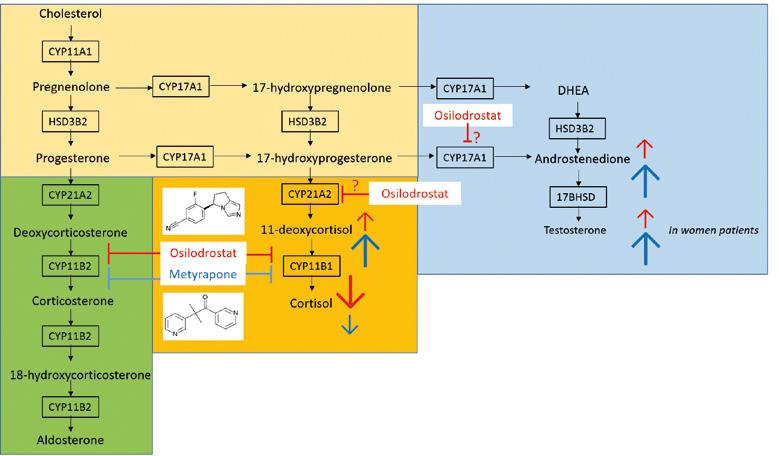
The enzymatic block of CYP11B induced by both molecules is responsible for a deviation of steroidogenesis to the androgen biosynthesis pathway. This induces an increase in androstenedione and testosterone levels, making clinical hyperandrogenism one of the main side effects reported in female patients. Moreover, in the context of ACTH-dependent Cushing’s syndrome, the decrease in cortisol level is often associated with an increase in ACTH level, still worsening the stimulation of the androgen biosynthesis pathway.
Despite their similar mechanisms of action, we found significant differences between osilodrostat and metyrapone in terms of serum steroid profile in our monocentric retrospective study,5 which included patients treated with either osilodrostat (n=25) or metyrapone (n=14) for ACTH-dependent Cushing’s syndrome in routine clinical care.
First, we showed that the cortisol level was lower in patients treated with osilodrostat than in those on metyrapone, resulting in a higher prevalence of cortisol deficiency in the osilodrostat group than in patients receiving metyrapone. This finding is particularly important in optimising patient care. Indeed, the introduction of osilodrostat treatment should always be accompanied by patient education on the risk of adrenal insufficiency. The addition of glucocorticoid supplementation (a block and replace strategy) should be considered in situations where rapid control of a severe cortisol excess is needed, often requiring quick dose escalation. In our cohort, 52% of patients treated with osilodrostat versus 28% of patients on metyrapone received glucocorticoid supplementation.
The second main difference was a greater increase in androgen levels in patients receiving metyrapone than in those on osilodrostat. Thus, androstenedione and testosterone levels in women patients were higher on metyrapone than on osilodrostat. This discovery also has an interesting clinical implication, with osilodrostat appearing to be a potential therapeutic alternative for women patients who present with clinical symptoms of hyperandrogenism after metyrapone treatment.
As expected, the level of 11-deoxycortisol, the direct cortisol precursor, was increased under both CYP11B1 inhibitors. However, as for androgens, this increase was significantly higher in patients treated with metyrapone than in those receiving osilodrostat.
These observations raised the question of potential differences in the spectrum of steroidogenic enzymes inhibited by the two drugs. The activity of steroidogenic enzymes can be indirectly assessed by the substrate:product ratio. Thus, the activities
of CYP11B1, CYP21A2 and CYP17A2 were further evaluated using the ratios of 11-deoxycortisol to cortisol, 17-hydroxyprogesterone to 11-deoxycortisol and androstenedione to 17-hydroxyprogesterone respectively.
Using this approach, metyrapone seemed to inhibit CYP11B1 more potently than osilodrostat, but the difference was not statistically significant in this small cohort of patients. Interestingly, the enzymatic activities of CYP21A2 and CYP17A1 17,20-lyase were, on the contrary, significantly lower in patients treated with osilodrostat than in those on metyrapone, suggesting an additional inhibitory effect of osilodrostat on both these steroidogenic enzymes.
However, these data on steroidogenic enzyme inhibition assessed ‘in vivo’ should be interpreted cautiously, as the concomitant circulating concentrations of osilodrostat and metyrapone remain unknown. Indeed, if the two molecules have almost the same molecular weight (metyrapone 226.27g/mol and osilodrostat 227.09g/mol), the dosage required for osilodrostat (median=10mg in this study) is about 100 times lower than that of metyrapone (median=1375mg). Osilodrostat also has a twofold longer half-life (4 hours) than metyrapone (2 hours), thus requiring only twice-daily drug intake, when three or four doses of metyrapone per day are often necessary.
These results need to be confirmed using larger cohorts of patients, and in other aetiologies of Cushing’s syndrome. An extended steroid profile, including mineralocorticoid as well as 11-oxoandrogen pathways, could also serve to complete these first data, which were obtained for a limited serum steroid profile.
Finally, determination of the circulating concentrations of the drug molecules in relation to the serum steroid profiles in patients will also give interesting insights into the drugs’ effective potencies in inhibiting the different steroidogenic enzymes.
All these approaches will allow a better understanding of both drugs’ mechanisms of action and side effects, resulting in improved patient management, particularly with regard to adaptation of drug dosage.
Fidéline Bonnet-Serrano Université Paris Cité, Inserm U1016-CNRS UMR8104, and Hormonology Department, Cochin Hospital, Paris, France
Effects
Recent research has sought to quantify cardiometabolic outcomes and mortality in patients with autonomous cortisol secretion, to inform management strategies.
Adrenal incidentalomas are detected in approximately 3.5% of computed tomography scans of the abdomen in patients over 60 years of age.1 These may secrete cortisol, and cortisol levels after 1mg dexamethasone (cortisolDST) are ≥50nmol/l in about 50% of patients. This is termed mild autonomous cortisol secretion (MACS), even though cortisolDST is ≥50nmol/l for other reasons in about 15% of the patients.
In the 2000s, MACS was associated with cardiometabolic risk factors and cardiovascular disease and, in the 2010s, with cardiovascular events and mortality.
Recently, a group from the European Network for the Study of Adrenal Tumors (ENS@T) published a study including 1305 patients with cardiometabolic complications.2 They found that patients with cortisolDST ≥138nmol/l more often had hypertension and treatment with three or more antihypertensives when compared with those with cortisolDST <50nmol/l (prevalence ratios 1.15 and 1.31 respectively). They were also more likely to be receiving insulin treatment for diabetes, but there was no increased prevalence of diabetes or dyslipidaemia. Cardiometabolic complications were not increased at cortisolDST levels between 50 and 137nmol/l. Thus, cortisolDST levels ≥138nmol/l are associated with metabolic complications and the association seems stronger when complications are more severe.
To make appropriate treatment decisions, the risks associated with specific levels of cortisolDST should be known.
Our group recently published a study on risk associated with three elevated levels of cortisolDST 3 The primary endpoint was all-cause mortality and the secondary endpoint a major adverse cardiovascular event (MACE). We followed 1048 patients for 6.4 years and endpoints were collected from national registries. The results were adjusted for sex, age, smoking, impaired renal function and pre-existing cardiovascular disease.
Patients with cortisolDST ≥138nmol/l had a twofold increased risk of MACE compared with those with cortisolDST <50nmol/l, but the risk was unchanged at 50−137nmol/l. Patients with cortisolDST levels of 83−137nmol/l or ≥138nmol/l had increased mortality (hazard ratios 2.30 and 3.04 respectively), whereas a cortisolDST of 50−82 nmol/l was not associated with increased mortality. We found a linear association between cortisolDST and mortality up to 200nmol/l. The mortality in cardiovascular disease was increased in patients with cortisolDST ≥83nmol/l but only non-significantly increased in cancer and other diseases.
One limitation is that the study does not provide evidence for causality, primarily because unmeasured confounders may exist. Furthermore, the risk may be underestimated since results are not based on verified autonomous cortisol secretion.
published a multicentre
with a median follow-up time of 7 years.4
1.52
with cortisolDST
including 3600
patients with cortisolDST levels ≥138nmol/l when compared with patients with cortisolDST <50nmol/l. The risk in patients with cortisolDST levels ≥138nmol/l thus seems lower than in our study.
The mortality increased linearly up to cortisol levels of 137nmol/l. Mortality in cardiovascular disease was increased and the mortality in cancer and other diseases was increased in parallel, but non-significantly. Furthermore, females and patients below 65 years had the highest relative increase in mortality in MACS.



The associations between cortisolDST and mortality in cardiovascular disease, cancer and other diseases in our patient cohort are shown in the Figure. These results indicate that MACS is associated with increased mortality not only in cardiovascular disease, but also in cancer and possibly other diseases. Treatment of cardiovascular risk factors may thus not fully mitigate the excess mortality. In addition, excess mortality may be independent of hypertension, dyslipidaemia and diabetes.4
Studies on the effect of surgery on mortality are consequently very important. A study published in 2020 reported cardiovascular mortality in a cohort of 29 patients operated on for MACS.5 Patients undergoing surgery seemed to have a more favourable outcome than those treated medically. This is not evidence that surgery reduces mortality, but a promising result.
MACS may also be present in subjects with undetected adrenal adenomas. This is termed hidden hypercortisolism and the prevalence has been estimated at 0.2−2.0% in the population and at 0.7−10.4% in patients with type 2 diabetes. Given a prevalence of adrenal incidentalomas of 3.5% in individuals above 60 years of age, and that 20% cause MACS with increased mortality, hidden hypercortisolism may be an unrecognised risk factor for mortality in up to 0.7% of subjects at this age. However, screening for hidden hypercortisolism should not be performed before an established treatment is available.
• CortisolDST is linearly associated with mortality up to 137−200nmol/l.
• The excess mortality is clinically significant at levels above approximately 83nmol/l, and 20% of patients have such levels.
• The excess mortality is in cardiovascular disease, and probably in cancer and ‘other’ diseases.
• Females and patients below 65 years may have the highest relative mortality.
• Medical treatment may not mitigate the excess mortality; adrenalectomy should only be recommended in selected patients until a beneficial effect has been proven.
Henrik Olsen Ängelholm Hospital and Lund University, Swedenof
and to 1.77 in
Endocrine nurses are widely respected members of the specialist teams who care for patients in our discipline. Their profile has risen gradually over the years − and is still rising.
In his book, The Innovator’s Prescription: A Disruptive Solution for Health Care, noted business writer Clayton Christensen described the evolution of healthcare from intuitive, to empirical, to precision medicine.1
Christensen describes intuitive medicine as a process of pattern recognition and intuitive experimentation, practised by highly trained individuals (e.g. endocrinologists identifying clinical ‘red flags’ suggesting a hormone imbalance). Over time, intuitive experimentation leads to the identification of specific patterns that respond to specific interventions producing a desired clinical outcome. Thus, empirical medicine is exemplified by evidence-based practice driven by the best available data (e.g. clinical guidelines).
In the era of precision healthcare, diagnosis, treatment and counselling are increasingly driven by molecular data and unique genetic signatures. Professional organisations such as ESE play a critical role in communicating scientific discovery to advance scientific knowledge, and in disseminating practice innovations to propel comprehensive, high quality care for patients, families and communities.
Interestingly, the evolution of our endocrine nursing societies has parallelled the transformation of medicine from intuitive practice to empirically based and precision approaches.
Cumulatively, the sharing of expertise and evidence across organisations helped propel endocrine nursing groups from specialised, intuitive practice towards empirically based nursing practice.
A landmark event for endocrine nursing came in 2013, when the Society for Endocrinology Nurse Committee published the Competency Framework for Adult Endocrine Nursing. This delineated the specific knowledge and skills for endocrine nursing practice relating to acromegaly, Cushing’s syndrome, dynamic endocrine testing, growth hormone deficiency, hypogonadism, hypopituitarism, steroid replacement for pituitary/adrenal disorders, thyroid disease, and transition from paediatric to adult-oriented care. It was updated in 2015.2
In 2019, a second landmark event saw an international group of endocrine nurses, from across the above-mentioned organisations, publish an endocrine nursing textbook, Advanced Practice in Endocrinology Nursing 3 The first of its kind, this two-volume edition has featured among the topselling textbooks published by Springer Nature.
Small groups of nurses working in endocrinology in the USA came together to found the Pediatric Endocrinology Nursing Society (PENS) and the Endocrine Nurses Society (ENS) in 1986 and 1988 respectively. The founding nurses either worked in endocrine practices or helped run clinical trials for endocrine disorders.
Broadly, both PENS and ENS sought to promote excellence in the art and science of endocrine nursing − reflecting the highly intuitive nature of the nursing care provided by select, highly specialised nurses. These organisations held annual meetings to help specialised endocrine nurses learn about scientific updates and share ‘best practice’ from their individual experience (i.e. intuitive practice).
With a growing recognition of the importance of having an ‘intellectual home’ for the discipline, other organisations followed suit and formed new endocrine nursing societies. The Society for Endocrinology in the UK formed a Nurse Committee in the early 2000s. Subsequently, ESE formed a Nurses’ Working Group in 2012 which became the ESE Nurse Committee in 2019. In parallel, the European Society for Paediatric Endocrinology (ESPE) formed a nurses’ group (ESPEN) in 2016.
Notably, there was significant cross-pollination across these endocrine nursing organisations leading to the formation of an international consortium of participants spanning North America (PENS, ENS), Europe (Society for Endocrinology, ESE, ESPEN), and Australasia (Endocrine Nurses’ Society of Australasia; ENSA).
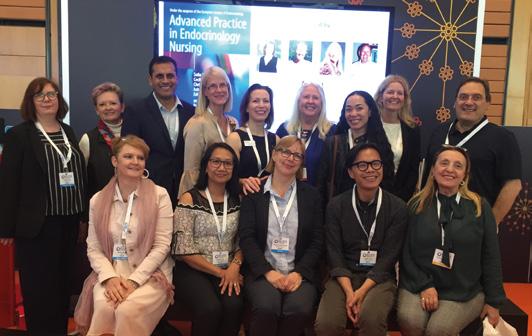
In 2017, the Federation of International Nurses in Endocrinology (FINE) was established with not-for-profit status.
Since the early 2000s, several organisations have published position statements to foster excellence in endocrine nursing practice. A recent milestone for endocrine nursing organisations was passed last year with global endorsement by PENS, ENS, ESE, ESPEN, ENSA and FINE of the Endocrine Nurses Society Position Statement on Transgender and Gender Diverse Care 4
Over the past 40 years, there has been significant growth among endocrine nursing societies. Cross-organisation collaboration has generated more evidence-based approaches for providing comprehensive, high quality endocrine care. At the same time, there has been growing cross-discipline appreciation of the unique contributions that nurses make to the field. Physicians and nurses regularly present together at international endocrine conferences and nurses participate in the development of clinical guidelines.
With the emergence of personalised (precision) medicine, endocrine nurses will continue to play a key role in providing holistic person-centred care.
Growing evidence suggests that idiopathic intracranial hypertension (IIH) is a systemic metabolic disease. This recent study examined the glucocorticoid (GC) metabolome associated with the condition.1
Idiopathic intracranial hypertension is an increasingly prevalent condition due to the obesity epidemic. It primarily affects women of reproductive age who have obesity.2
People with IIH present with raised intracranial pressure (ICP), chronic headaches and papilloedema which, if left untreated, can cause blindness. Recent evidence suggests that IIH is a disease of metabolic dysfunction; those with the condition have abdominal obesity, with insulin and leptin resistance in excess of that conferred by obesity.3 Adipose tissue in IIH is transcriptionally primed for increased calorie intake, with a unique depot-specific lipogenic profile.3 Additionally, women with IIH have a distinct androgen excess phenotype, consisting of increased serum and cerebrospinal fluid testosterone.4 This metabolic phenotype probably underpins the recently identified clinical findings of a higher risk of cardiovascular disease and type 2 diabetes mellitus compared with control subjects with obesity.2 Additionally, the finding of decreased birth rates in IIH, with increased risk of gestational diabetes and pre-eclampsia, may stem from underlying metabolic dysfunction.5
Excess GCs are a known determinant of metabolic disease. Indeed, GCs have previously been implicated in the pathophysiology of IIH; a significant correlation has been observed between the change in 11β-hydroxysteroid dehydrogenase type 1 (11β-HSD1) activity and the change in ICP.6 No studies have investigated the basal GC phenotype in IIH so, in this recent research, we aimed to define the IIH GC metabolome and determine the origin of any findings.1
We took meticulously phenotyped women with IIH, and controls matched for age, sex and body mass index.1 We compared their urinary steroid profiles using mass spectrometry. In our randomised control trial of bariatric surgery in IIH, we assessed the urinary steroid profile of the participants at baseline and 12 months.7 Additionally, adipose biopsies from patients with IIH and controls were incubated with cortisone to assess 11β-HSD1 activity.
We demonstrated that people with IIH have increased 11β-HSD1 activity and increased urinary cortisol compared with controls (see Figure). In addition, 5α-reductase activity, a marker of GC clearance, was increased in IIH. No other steroids that we assessed were found to be altered in patients with IIH. There was no increase in total GC excretion, indicating no overt GC excess. This suggests a tissue-specific dysfunction, rather than adrenal or hypothalamic–pituitary–adrenal axis dysfunction.
Weight loss has been proven to induce remission of IIH. Urinary steroid analysis before and after weight loss demonstrated that, following bariatric surgery, there was a reduction in 11β-HSD1 activity. This change in 11β-HSD1 activity correlated with change in lumbar puncture opening pressure, which is a measure of IIH disease activity. This could suggest that GCs have a role to play in the regulation of ICP in the context of IIH.
Subsequently, subcutaneous adipose analysis showed that patients with IIH have a 300% higher 11β-HSD1 activity compared with controls.
together, our data

that people with IIH have increased
both systemically and in adipose tissue. This supports
evidence that IIH is a complex metabolic disease and not just a neuro-ophthalmological disease. In the future, an endocrine approach to management
become increasingly pertinent.
Connar SJ Westgate, Susan P Mollan and Alexandra J Sinclair Institute of Metabolism and Systems Research, University of Birmingham, and University Hospitals Birmingham NHS Foundation Trust, UK
Idiopathic intracranial hypertension (the former label ‘benign’ has, quite rightly, been dropped) is severe and debilitating. Disordered GC metabolism and, particularly, altered 11β-HSD1 activity have been implicated in its aetiology, but the picture may be complex. 11β-HSD1 catalyses interconversion of inactive corticosterone and active cortisol. It is believed generally to activate GC in vivo, though, in the correct conditions, it can catalyse inactivation. Activating activity is increased in choroid plexus in IIH, but an 11β-HSD1 antagonist only minimally lowered intracranial pressure. Moreover, active Cushing’s syndrome is not clearly associated with IIH, while numerous reports describe IIH on acute GC lowering or chronic deficiency. This careful study adds further pieces to the puzzle by addressing 11β-HSD1 activity in peripheral tissues in IIH, showing increased systemic activity, and markedly increased activity in adipose tissue. Levels were reduced by weight loss, and correlated with reduced intracranial pressure. This suggests that disordered GC metabolism may be important, not only in IIH itself, but also in the associated metabolic abnormalities. This creates new opportunities for treatment, though the discrepant observation of IIH in GC deficiency emphasises the importance of drilling down on 11β-HSD1 activity tissue by tissue. More studies are awaited with interest.
Laura de Graaff describes recent work to improve transition from paediatric to adult endocrinology in patients with rare endocrine genetic syndromes (ReGS).1
Congenital endocrine disorders, like ReGS, are usually detected and treated by paediatric endocrinologists. Thanks to improved multidisciplinary medical care during childhood, more patients now reach adulthood. However, transition to adult healthcare is often poor and leads to fragmentation of care. Little is known about the (management of) medical problems in individuals at an adult age. Paediatric guidelines often contain insufficient or incorrect data about adults, and literature on adult patients is scarce. This often leads to over- and undertreatment2 and medical complications.
At the Erasmus MC Center for ReGS in Rotterdam, The Netherlands, we aim to improve the quality of healthcare for adults with ReGS, combining specialised multidisciplinary care with innovative basic and clinical research. In the last 6 years, we have provided multidisciplinary care to over 1000 adults with over 75 ReGS. Transition is an important topic in improving clinical care for adults with these conditions.
The transition from the paediatrician to the adult endocrinologist can be difficult for the patient, the parents and the doctor. One in every four(!) young people fail to show up at the outpatient clinic. This so called ‘dropout’ poses a health risk for young adults, as it can lead to non-compliance and serious, expensive acute and long term medical complications.
To make this transition easier and safer, we have started a special transition consultation hour, together with the paediatric endocrinologists, in which we offer tailor-made transition care. We also conduct research into how we can make transition safer and more fun.
In our recent paper in Endocrine Connections, 1 we describe our study in around 400 adolescents with endocrine disorders, including disorders of sex development, adreno-genital syndrome, Turner syndrome, Klinefelter syndrome, Prader−Willi syndrome and Silver−Russell syndrome. All patients were over 15 years old when they attended the paediatric endocrine outpatient clinic of our hospital in 2013−2014 and should have made the transfer to adult care at the time of the study.
Of almost 400 adolescents, one third (131 patients) had an indication for adult follow-up within our university hospital, but 25% of them were lost to follow-up. Interestingly, drop-out seemed to be caused by logistical

Sadly, we may already be rather familiar with the findings of this article by Davidse et al. In the Erasmus Medical Center, an exceptionally wellresourced facility that most would agree is one of Europe’s leading academic and clinical endocrine institutions, 25% of paediatric patients requiring transfer to adult care do not make it. Similar data have been reported from other centres.
What is perhaps most concerning is that, in the majority of these cases, it is not patient avoidance or resistance that is responsible, but straightforward administrative errors. Appointments were not made or sent. With increasing success in treating and managing many of the less common endocrine diseases that present in childhood, we have to do better than this. The authors discuss mechanisms to overcome this hurdle (e.g. appointment of a transition co-ordinator), but this paper highlights the need for clinical endocrinologists to examine their local practice with transition, and to develop systems to optimise the process.
Clarkmistakes in 73% of instances! Our work details the failures in logistical processes that eventually led to drop-out in these patients. To prevent these drop-outs, we provide practical recommendations for patients and paediatric and adult endocrinologists.
Apart from the logistical steps, it is also important to look at transition readiness. In a previous study by our group,3 we showed that several self-management skills, such as medical knowledge, practical skills and communication, were insufficient among patients with rare endocrine disorders.
We found that self-management skills were only weakly related to nonmodifiable factors, such as age and gender. Therefore, we recommend focusing on modifiable factors, like personalising the amount and ‘mode’ of medical information and the use of transition checklists to detect shortcomings in practical skills and communication. These ‘shortcomings’ can subsequently be addressed by training with the help of parents or caregivers and … a game!
In collaboration with a number of patients, we have developed a transition game for young people from 14 years of age. The game prepares the youngsters for independence in a light-hearted way. It is a real-life game, which takes, at most, 10 minutes per day. During the game, the players have to solve a mystery, and they encounter all kinds of problems. By playing the game, they learn all kinds of self-management skills in a playful way.
In the coming years, the game will be tested in several countries and we will investigate whether the game indeed improves self-management skills and prevents drop-out. After the game has proven effective, we will consider making it available for transition in other disciplines, such as rheumatology and gastroenterology.
Laura de Graaff Genetic and Developmental Endocrinologist, Erasmus MC for Rare Endocrine Genetic Syndromes, Rotterdam, The Netherlands
Endocrine nurses often come into patients’ lives at a time of stress and change. Nurses may well be a patient’s most regular source of healthcare support. The bond that forms between a patient and nurse is invaluable, as these two patients with pituitary conditions explain.
In my experience of seeing endocrinology nurses in clinic, or speaking over the phone, the help and reassurance I have received, and the practical advice over medication issues, have been exemplary.
In years gone by, there was neither an endocrinology department nor a nurse. I was left to get on with it! There was no advice on sick day rules. No emergency injection kit and few occasions when my blood tests were done. I just bumbled along, seeing my GP, who was as much in the dark as I was.
I had a craniopharyngioma in 1974: hypopituitarism at age 14, no testosterone replacement, no puberty. Our endocrinology clinic opened in the late 1980s. The nurses were great to speak to, and the knowledge
they shared was incredible. My health improved. And I had a number to call for help. Wow!
My condition has always been complicated. My nurse applied her extensive knowledge, but always in a friendly, caring way. Having this openness with nurses at clinic and using a phone contact system gives me huge reassurance with my condition.
Through many problems, struggling as a result of changes in medication, I remember how nurse Nikki Kieffer helped me. Without this care, I am convinced I would have died years ago.

For more information about any ESE event see www.ese-hormones.org.
ESE Spotlight on Science
3 November 2022
Online
EuroPit 2022
20–23 November 2022
Annecy, France
ESE Talks 29 November 2022 Online
ESE Clinical Update on Obesity and Female Reproduction 2023
10–12 January 2023
Online
I have acromegaly, something I had never heard of before my diagnosis way back in 2001. At the beginning of my long journey with my pituitary condition, when I realised that the ‘cure’ was brain surgery, I must admit I was very scared.



I was under King’s College Hospital, and they have a Pituitary Investigation Unit, run by the endocrine nurses. I was in there several times before my op, for various tests. Again, this was all new to me, as I had never really had much to do with hospitals before.
The staff there were very calm and matter of fact with all the tests. They were all very caring and would take the time to explain anything they were doing.
But it was Patsy who was in charge of the unit at the time I was first there who was so friendly. She had a way of making you feel that everything was normal and nothing was sinister, as they had seen it all before, so it was all going to be fine.
After all this time, I am still under King’s, still having the tests. Different nurses are there now, but I will never forget how kind and caring Patsy and her team were, back in the beginning.
13–16 May 2023
Istanbul, Turkey
In person and online
ESE Summer School 2023 18–21 June 2023
Innsbruck, Austria
EYES Annual Meeting 2023
8–10 September 2023
Würzburg, Germany
EuroPit 2023 19–22 November 2023
Annecy, France